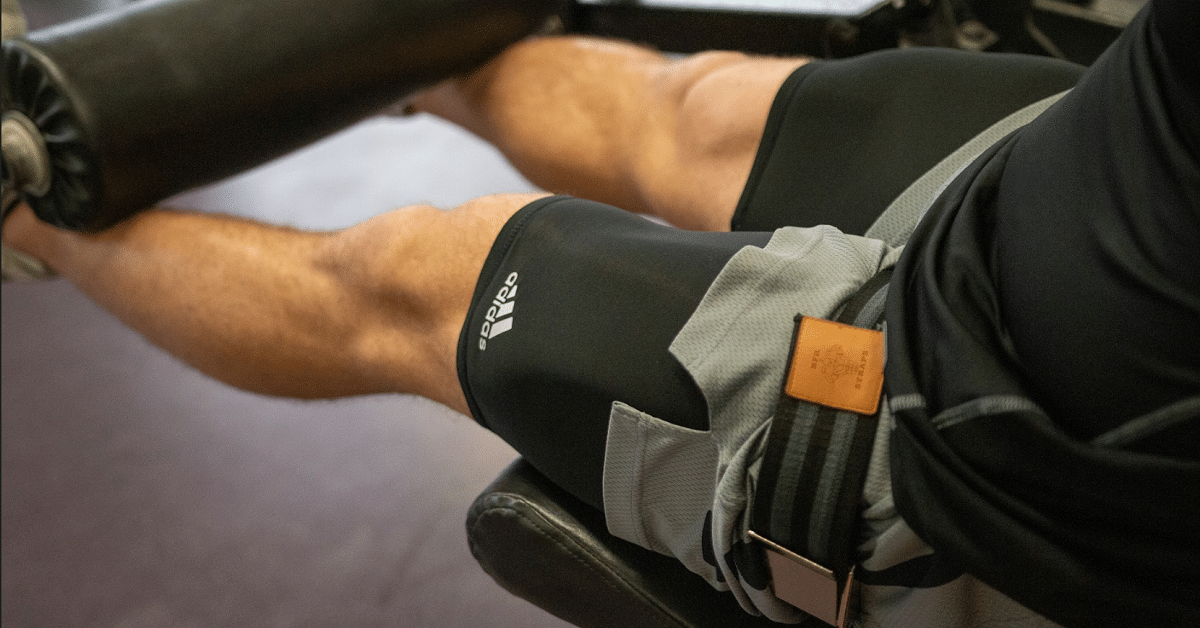Safety is our highest priority. We never want to compromise safety for performance.
That’s why it’s critical to ask before starting any new training protocol: Is it safe?
It’s especially critical to ask this question before using a tactic like “blood-flow restriction training.” We’re literally restricting blood flow. Sounds questionable.
So let’s check the science to make sure it’s safe before incorporating it into our workouts.
We’re here to provide further information about BFR protocols, and provide some safety tips to ensure maximum results without injury. Let’s dive in.
First things first: What is BFR?
It’s become a fairly common sight to see someone at the gym with a band wrapped around their arm, making wildly painful faces even though they’re only using 10’s or 15’s on arm curls.
If you were curious enough to ask them what they were doing, you’d likely get a different response from every different person you asked. However, what they’re doing is called Blood Flow Restriction, also known as BFR.
If you’re looking for answers, here they are – yes, BFR works. No, BFR does not provide huge quads or triceps with any random reps or sets. Worse, it could potentially be detrimental. Physiology ahead, bear with me.
It all starts with the pump
Let’s start with the scientific part. To fully understand blood flow restriction exercises and how it impacts the muscles, we have to get back to basic physiology. Working out will have your body contract in 3 different ways:
- Concentrically (by shortening the muscle)
- Isometrically (by holding muscle at a fixed position)
- Eccentrically (by lengthening the muscle)
The good almighty pump that makes us look so good in the mirror is a reaction to those contractions and lengthening. The blood pool increases and your veins either congest or distend (Loenneke, 2010). Each type of contraction paired with specific intensities will create a different path of blood flow.
For example, if you decide to curl an EZ bar for 20 repetitions with a regular tempo of 1 second up/1 second down, the path your blood will follow will be different than if you were to do 6 reps with higher weight and slowing down when bringing the weight down.
Numerous protocols can be used depending on the volume and intensity of your sets. More on that here.
Why is it better than a regular pump up set?
The mechanism for the increase in post-exercise blood flow compared to traditional training is still unknown.
Currently, researchers are coming up with potential explanations. One of them makes a lot of sense and was proposed by Loenneke et al. (2010) :
“The accumulation of metabolites and the decreased availability of oxygen could result in the recruitment of fast twitch fibers at lower than expected exercise intensities”.
What does it mean in non-geeky words? Here is a short explanation. Our muscles are composed of different types of fibers :
- Slow-twitch fibers : are mostly responsible for endurance gains. The force of contraction is lower, but fatigue doesn’t set as fast. A marathon runner will mostly use slow-twitch fibers (or Type I fibers). Training Type I fibers requires longer duration workouts.
- Fast-twitch fibers: are mostly responsible for gains in size and strength, can contract forcefully but get easily tired. A 100m sprinter will mostly use fast-twitch fibers (or Type II fibers). Require short high-intensity training in order to be recruited.
We want to get bigger and we want to get stronger, easy enough. We just have to lift heavy right? Ideally, yes.
However, we can’t train at a high-intensity 24/7 without burning ourselves out. So what?
This is where BFR comes into play.
Whether you are a meathead whose body has taken a toll from heavy lifting and needs a break/deload (we’ve all experienced knee and elbow tendonitis and a fried central nervous system at some point), an athlete recovering from injury who has limitations, or simply a seasoned lifter who doesn’t care about sporting prowesses but is only interested in looking good shirtless, we all have something to gain from BFR training.
Let’s get back to what has been said before, the whole point of BFR is to get the same result as the traditional training methods using MUCH LOWER weights. If less weight needs to be moved in order to get similar results, BFR can be used for many different purposes:
- Decrease joints’ exposure to stress
- Maintain the size of an injured limb (for example, pre- and post ACL surgery)
- Taking hypertrophy to another level while minimizing CNS (central nervous system) fatigue
- Add new stimulus to a training routine to break a plateau
The list is impressive. You seem convinced that it could take your physique to levels never reached before, but wait a minute… I still don’t know if it is safe?
Am I going to lose my arm or my legs?
When compared to resistance training alone, it appears that blood flow is impaired post-exercise, but is actually enhanced when several bouts of exercise are repeated (Patterson, 2010).
Although it is still hard to determine how much better BFR is compared to standard training methods, our primary concern should always be to first make sure that it is safe. Don’t panic! We laid out a several reasons why BFR is perfectly safe:
1.Cardiovascular System
Loenneke et al. studied the effect of BFR on the cardiovascular system (peripheral blood flow changes, central response of the cardiovascular system and blood coagulation). After analysis of cardiac output and stroke volume during BFR training, they showed that cardio-vascular responses were not significantly different than traditional training methods.
This means that low-intensity BFR training is a safe alternative and does not impair blood flow.
2.Blood Coagulation
This is the biggest risk area if you don’t pay attention to general BFR guidelines (cf. BFR training 101 article). Here’s a quick reminder:
- More is not always better
- Wrapping your BFR bands to the point of total occlusion could lead to venous thrombosis, the formation of a blood clot that forms within a vein
- Use adapted bands, with appropriate width and thickness
- The tighter they get the less time they should be worn to prevent excessive damage
Rest assured, researchers found that if wrapping tension is respected, coagulation activity doesn’t appear to increase following low-intensity BFR exercise!
3.Muscle Damage
For many years, it was a common understanding that in order to BUILD MUSCLE, you have to BREAK it down first. To this day, many still consider great workouts to be the ones that get you the most sore. I’ve seen countless people changing personal trainers or training routines because they weren’t getting “sore”.
While it couldn’t be further from the truth, here’s what really makes you get better as a natural lifter:
- Your body’s ability to adapt to specific stimuli (sets, reps, time under tension, etc.)
- Frequency
- Consistency
Note: take a minute and read this article written by Christian Thibodeaux.
The longer DOMS (delayed onset muscle soreness) is limiting your ability to train, the less frequently you will train at the intensity and frequency required in order to make significant improvement. Long story short, it’s good to train hard. However, you’ll get better results by manipulating daily/weekly volume instead of going all out everyday.
Now let’s be honest, if you ever tried a BFR protocol to finish a leg workout, getting out of bed the next morning was an extreme challenge. Wait, that doesn’t make any sense! You just said that soreness wasn’t a good thing!
True! But you also probably noticed that your soreness went away FASTER than usual. Compared to traditional training methods, studies have shown that perceived soreness after 24h in the BFR group (following the same protocol) was lower, with no increases in perceived soreness at any other point in time (Umbel, 2009).
Here you go, all you “soreness aficionados” will still be satisfied and still be ready to go next leg day!
Observing that low-intensity blood flow restriction only causes minimal muscle damage WHILE increasing metabolic stress, muscle hypertrophy and recruitment of muscle fibers is the real GAME CHANGER!
To read more about the potential false relationship between muscle damage and hypertrophy, Dr. Schoenfeld wrote several articles that are worth the read.
4.Nerve Conduction Velocity
Last but not least, what about the nerves? Is BFR training going to have a negative impact on the ability to control your body, to feel and move around? Is the feeling of numbness that comes along with BFR cause for alarm? Several researchers decided to answer that question, observing the change in nerve conduction velocity (speed at which an electrochemical impulse propagates down a neural pathway, also known as NCV) when compression is applied on a limb (Mittal, 2008).
Findings were that low-intensity blood flow restriction training does not seem to have a chronic negative effect on NCV. Unfortunately, this means you can’t blame your poor video game skills on those few BFR sets you did.
Long story short
You might have heard it said before that “BFR straps could cause a subcutaneous hemorrhage (large bruise), numbness (straps being too tight), or rhabdomyolysis (death of muscle fibers and release of their contents into the bloodstream)”. But so could traditional training methods if guidelines and precautions are not followed. We once again ask you to read “BFR Training 101: A Scientifically Proven Way to Build Muscle Faster” and to follow the 5 T’s correctly for your own safety!
BFR straps should always be wrapped around the upper leg and upper arm! People often ask about wrapping at the knees and elbows like powerlifters do. This is a completely different concept. They are using it to store extra elastic energy (from the elastic band) to assist with the movement (squat or bench press). The wraps act as a spring when compressed. BFR training protocols do not ever recommend wrapping at the knees or elbows.
In conclusion and based on our researches, compared to traditional training methods and when safety precautions are taken, we observed that BFR training:
- Does NOT impair blood flow
- Does NOT increase coagulation activity
- Does NOT increase muscle damage
- Does NOT negatively impact nerve conduction velocity
Therefore, wrap the bands on appropriately and enjoy the pump!
References:
- Loenneke, J., Wilson, J., Wilson, G., Pujol, T., Bemben, M. 2011. “Potential Safety Issues with Blood Flow Restriction Training.” Scandinavian Journal of Medicine and Science in Sports. 21 (4): 510-518. DOI: https://doi.org/10.1111/j.1600-0838.2010.01290.x.
- Nakajima, T., Kurano, M., Iida, H., Takano, H., Oonuma, H., Morita, T., Meguro, K., Sato, Y., Nagata, T. 2005. “Use and Safety of KAATSU Training : Results of a National Survey.” International Journal of KAATSU Training Research. 2 (1): 5-13. DOI: 10.3806/ijktr.2.5.
- Clark, B., Manini, T., Hoffman, R., Williams, P., Guiler, M., Knutson, M., McGlynn, M., Kushnick, M. 2011. “Relative Safety of 4 Weeks of Blood Flow‐Restricted Resistance Exercise in Young, Healthy Adults.” Scandinavian Journal of Medicine and Science in Sports. 21 (5): 653-662. DOI: https://doi.org/10.1111/j.1600-0838.2010.01100.x.
- Crisafulli, A., De Farias, R., Farinatti, P., Lopes, K., Milia, R., Sainas, G., Pinna, V., Palazzolo, G., Doneddu, A., Magnani, S., Mulliri, G., Roberto, S., Oliveira, R. 2018. “Blood Flow Restriction Training Reduces Blood Pressure During Exercise without Affecting Muscle Metaboreflex.” Frontiers in Physiology. 9: 1736. DOI: 10.3389/fphys.2018.01736.
- Souza, T., Pfeiffer, P., Pereira, J., Pereira, N., Elisio, A., Dutra, T., Mendonca, M., Cirilo-Sousa, M. 2019. “Immune System Modulation in Response to Strength Training With Blood Flow Restriction.” The Journal of Strength and Conditioning Research. Volume Published Ahead of Print. DOI: 10.1519/JSC.0000000000003323.
- Chen, Y., Hsieh, Y., Ho, J., Lin, J. 2019. “Effects of Running Exercise Combined With Blood Flow Restriction on Strength and Sprint Performance.” The Journal of Strength and Conditioning Research. Volume Published Ahead of Print. DOI: 10.1519/JSC.0000000000003313.
- Umbel, J., Hoffman, R., Dearth, D., Chleboun, G., Manini, T., Clark, B. 2009. “Delayed-Onset Muscle Soreness Induced by Low-Load Blood Flow-Restricted Exercise.” European Journal of Applied Physiology. 107 (6): 687–695. DOI: 10.1007/s00421-009-1175-6.
- Mittal, P., Shenoy, S., Sandhu, J. 2008. “Effect of Different Cuff Widths on the Motor Nerve Conduction of the Median Nerve: An Experimental Study.” Journal of Orthopedic Surgery and Research. 9 (3): 1. DOI: 10.1186/1749-799X-3-1.


